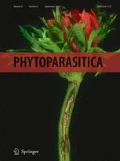Abstract
HRI has adopted the strategy of establishing reference populations for genome mapping of horticultural species. In the case ofBrassica oleracea, doubled haploid families have been generated from crosses between subspecies. These lines can be maintained indefinitely by selfing, allowing accumulation of large amounts of data on defined genotypes (using molecular markers) which are then linked with replicated phenotypic assessment In the case of apple, reference progeny segregating for a large number of genes have been established and replicated by grafting for distribution to different regions of Europe. For both species, data are organised in relational databases, allowing full analysis of any relationships which might exist. Methods are being developed to optimise the process of identifying informative molecular markers, with particular emphasis on markers which can be used for a wide range of species.
Similar content being viewed by others
References
Alston, F.H.; Watkins, R. (1975) Apple breeding at East Mailing. In: Brown, A.G., Watkins, R. and Alston, F.H. [Eds.]Proceedings of the Eucarpia Fruit Section Symposium V, Canterbury 1973, pp. 14–29.
Brown, A.G. (1960) The inheritance of shape, size and season of ripening in progenies of cultivated apple.Euphytica 9, 327–337.
Crute, I.R.; Pink, D.A.C. (1989) The characteristics and inheritance of resistance to clubroot inBrassica oleracea. Aspects of Applied Biology 23, 57–60.
King, G.J. (1990) Molecular genetics and breeding of vegetable brassicas.Euphytica 50, 97–112.
King, G.J.; Alston, F.A.; Batlle, I.; Chevreau, E.; Gessler, C.; Janse, J.; Lindhout, P.; Manganaris, A.G.; Sansavini, S.; Schmidt, H.; Tobutt, K. (1991) The European Apple Genome Mapping Project — developing a strategy for mapping genes coding for agronomic characters in tree species.Euphytica 56, 89–94.
Stam, P. (1991) Constructing integrated genetic maps.Abstracts of Symposium on Plant Breeding in the 1990s. North Carolina State University, Raleigh, NC.
Williams, J.G.K.; Rubelik. A.R.; Livak, K.J.; Rafalski, J.A.; Tingey, S.V. (1990) DNA polymorphism amplified by arbitrary primers are useful as genetic markers.Nucleic Acids Research 18, 6531–6535.
Author information
Authors and Affiliations
Rights and permissions
About this article
Cite this article
King, G.J. Strategy and techniques for mapping horticultural genomes. Phytoparasitica 20 (Suppl 1), S93–S97 (1992). https://doi.org/10.1007/BF02980416
Issue Date:
DOI: https://doi.org/10.1007/BF02980416




